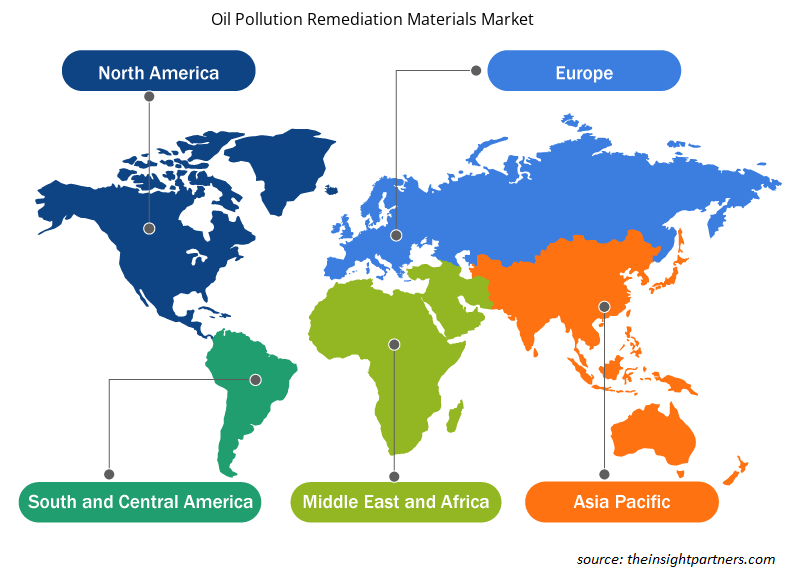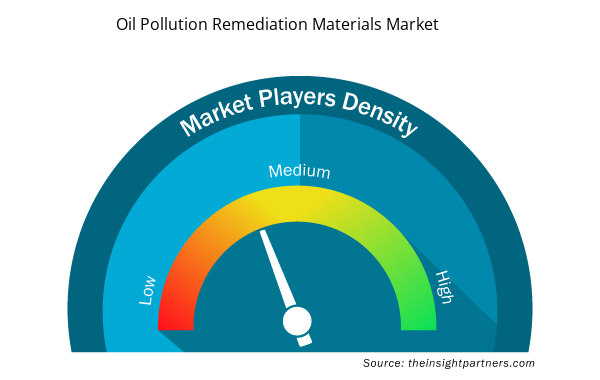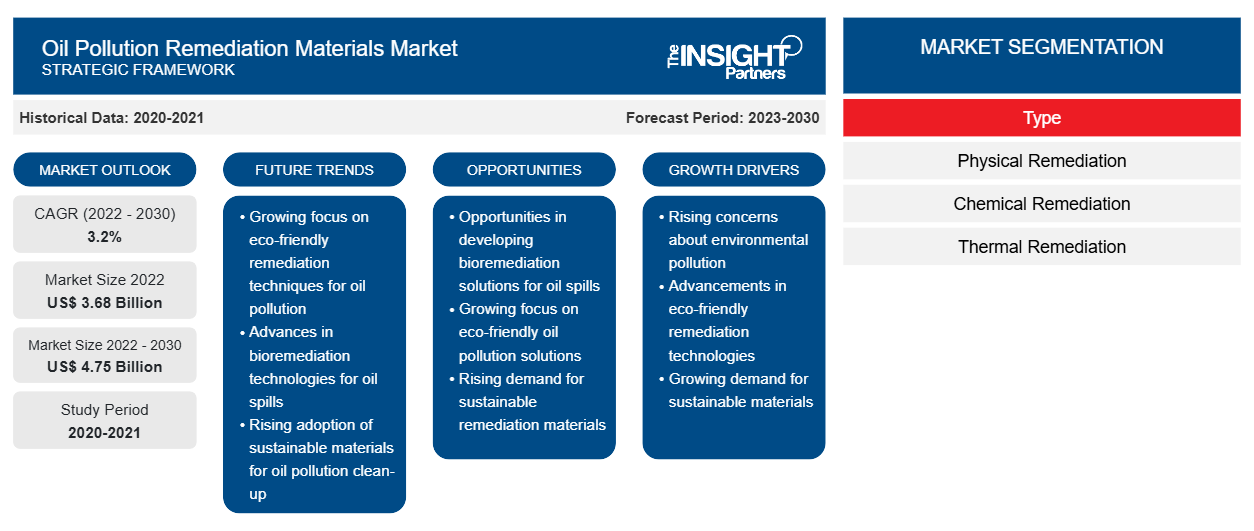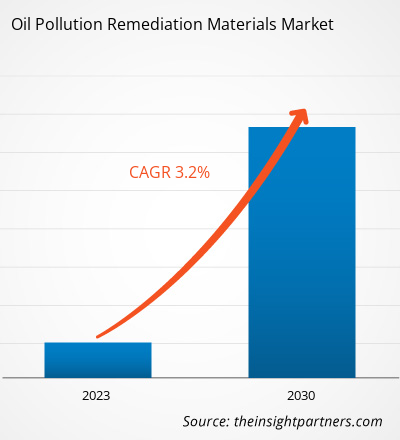[調査レポート] 油汚染修復材市場分析は、2022年に36億8,436万米ドルと評価され、2030年までに47億4,956万米ドルに達すると予想されています。2022年から2030年にかけて3.2%のCAGRを記録すると予測されています。
市場分析
油汚染修復材は、世界中で行われているさまざまな石油探査、輸送、産業活動による水域の汚染リスクを軽減するために使用されています。修復技術は、主に物理的修復、化学的修復、熱的修復、および生物的修復に分類されます。これらは、海洋油流出の問題に取り組む上で非常に重要であると考えられています。物理的修復は、ブーム、スキマー、および吸着材などの材料で構成されます。化学的修復材には、分散剤と固化剤が含まれます。
油汚染修復材市場の成長を牽引する主な要因は、沖合での石油探査と輸送活動の増加、および石油流出への備えと対応に関する政府規制です。過去数年間、さまざまな国の政府は、環境上の緊急事態に迅速かつ効果的に対応できるように、油流出の浄化規制を策定してきました。これらの規制では通常、企業が油流出を封じ込め、制御し、浄化するために従わなければならない手順、技術、および基準が概説されています。規制では、環境への影響を最小限に抑え、効果的な浄化を確実にするために使用する必要がある修復材の種類が規定されることがよくあります。効果的な油流出浄化の必要性が高まるにつれて、修復材の需要が高まっています。
環境への懸念と規制が強化されるにつれ、修復に先進的で環境に優しい材料を使用することの重要性が高まっています。特定の吸収剤、分散剤、バリアは、安全性と有効性の基準を満たすことが義務付けられる可能性があり、油流出対応活動において環境に優しく効率的な材料の使用が促進されます。政府と石油業界は、定期的な油流出対応を実施するための準備計画を立てています。油流出に迅速に対処し、生態学的影響を最小限に抑えるという政府の義務により、吸収剤、分散剤、その他の修復材料の需要が高まっています。2023年、米国環境保護庁は、連邦政府の国家緊急時対応計画(NCP)に基づき、米国の海域と隣接する海岸線での油流出対応を改善するための基準を強化しました。基準には、化学薬品や生物剤などの効果的な油流出修復製品の開発、およびこれらの製品の使用に関する透明性と情報の提供が含まれます。
沖合での探査や掘削活動の増加、パイプラインやタンカーによる石油輸送、石油の抽出や貯蔵中の人為的ミスにより、石油流出事故の可能性が高まっています。国際エネルギー機関によると、世界の石油需要は2021年に回復し、2025年までにアジアが石油需要の77%を占めると予想されています。アジアの石油輸入必要量は、2025年までに1日あたり3,100万バレルを超えると予想されています。アジア太平洋地域のさまざまな国の政府は、この地域の石油需要の高まりに対応するために石油プロジェクトを開始しています。2023年、ペトロナスとその石油協定請負業者は、19件の石油およびガス探査発見と2件の探査評価成功を報告し、マレーシアに10億バレル以上の石油換算の新規資源をもたらしました。これは、過去数年間に実施された強化された探査プログラムの結果であり、25の井戸が掘削されました。これは2015年以降、1年間に掘削された探査井の数としては最多となる。
成長の原動力と課題
米エネルギー情報局が2024年1月に発表した報告書によると、2024年1月9日現在、COVID-19パンデミック以降、原油生産量が増加しており、2年間の減少から反転している。米国の原油生産量は、2021年の1,127万バレル/日から2023年には1,321万バレル/日に増加し、2024年までに1,344万バレル/日に達すると予測されている。カナダエネルギー規制当局によると、カナダで生産される原油のほとんどは、西部の州からパイプラインを使用して米国、オンタリオ州、ケベック州の製油所に出荷されている。ブリューゲルAISBLが2023年に発表した報告書によると、ロシアは2021年に世界最大のエネルギー生産国および消費国トップ5に入った。同年、ロシアは5億9,520万トンの原油を生産し、そのうち2億8,660万トンが輸出された。したがって、沖合での石油探査と輸送活動の増加が、油汚染修復資材市場を牽引しています。
要件に合わせてレポートをカスタマイズする
このレポートの一部、国レベルの分析、Excelデータパックなど、あらゆるレポートを無料でカスタマイズできます。また、スタートアップや大学向けのお得なオファーや割引もご利用いただけます。
- このレポートの主要な市場動向を入手してください。この無料サンプルには、市場動向から見積もりや予測に至るまでのデータ分析が含まれます。
レポートのセグメントと範囲
「世界の油汚染修復材市場予測分析」は、種類と地域というセグメントを考慮して実施されました。レポートでは、世界中の油汚染修復材の使用に関する主要な統計と、主要な地域と国での需要が示されています。さらに、レポートでは、主要な地域と国での市場パフォーマンスに影響を与える要因の定性的な評価も提供しています。また、油汚染修復材市場の主要プレーヤーと主要な戦略的展開の包括的な分析も含まれています。市場ダイナミクスの分析も含まれており、主要な推進要因、市場動向、収益の増加につながる有利な機会を特定するのに役立ちます。
エコシステム分析とポーターの 5 つの力の分析により、世界市場の 360 度のビューが提供され、サプライ チェーン全体と、油汚染修復材料市場の成長に影響を与えるさまざまな要因を理解するのに役立ちます。
セグメント分析
世界の油汚染修復材料市場は、タイプに基づいてセグメント化されています。タイプに基づいて、市場は物理的修復(ブーム、スキマー、吸着材)、化学的修復(分散剤と固化剤)、熱修復、および生物修復に分類されます。物理的修復セグメントは、最大の油汚染修復材料市場シェアを占めています。物理的修復は、水環境での油流出を制御するために一般的に使用されます。これは、水面に残っている油をその特性を変えることなく封じ込めて回収するために使用されます。また、物理的および化学的特性を変えることなく、油流出の拡散を制御するための障壁として主に使用されます。物理的修復方法を使用する最も一般的な利点は、油がその特性を保持することです。したがって、油は将来も精製して使用することができ、廃棄物を減らし、経済的損失を軽減する可能性があります。物理的修復プロセスには、ブーム、スキマー、吸着材が含まれます。
地域分析
このレポートでは、北米、ヨーロッパ、アジア太平洋 (APAC)、中東およびアフリカ (MEA)、中南米の5つの主要地域における世界の油汚染修復資材市場の詳細な概要を提供しています。中東およびアフリカ (MEA) は、世界の油汚染修復資材市場で最大のシェアを占め、2022年には15億米ドルを超えると評価されました。中東およびアフリカ (MEA) は、この地域で操業している主要な石油掘削事業の存在を示しています。アジア太平洋 (APAC) の市場は、2030年までに10億米ドルを超えると予想されています。北米の市場は、2022年から2030年にかけて約3%のCAGRを記録すると予想されています。中東およびアフリカには主要な原油埋蔵量があり、この地域では過去数年間に原油探査活動の数が著しく急増しています。石油の探査と生産活動を支援する技術の発展により、石油流出のリスクが高まり、石油汚染修復材料とサービスの需要が高まっています。したがって、技術の発展は、中東とアフリカにおける石油汚染修復材料の市場規模の拡大に貢献しています。
油汚染修復材料市場の地域別洞察
予測期間を通じて油汚染修復材市場に影響を与える地域的な傾向と要因は、Insight Partners のアナリストによって徹底的に説明されています。このセクションでは、北米、ヨーロッパ、アジア太平洋、中東、アフリカ、南米、中米にわたる油汚染修復材市場のセグメントと地理についても説明します。

- 油汚染修復材料市場の地域別データを入手
油汚染修復材料市場レポートの範囲
| レポート属性 | 詳細 |
|---|---|
| 2022年の市場規模 | 36億8千万米ドル |
| 2030年までの市場規模 | 47億5千万米ドル |
| 世界のCAGR(2022年 - 2030年) | 3.2% |
| 履歴データ | 2020-2021 |
| 予測期間 | 2023-2030 |
| 対象セグメント | タイプ別
|
| 対象地域と国 | 北米
|
| 市場リーダーと主要企業プロフィール |
|
市場プレーヤーの密度:ビジネスダイナミクスへの影響を理解する
油汚染修復材市場は、消費者の嗜好の変化、技術の進歩、製品の利点に対する認識の高まりなどの要因により、エンドユーザーの需要が高まり、急速に成長しています。需要が高まるにつれて、企業は提供品を拡大し、消費者のニーズを満たすために革新し、新たなトレンドを活用し、市場の成長をさらに促進しています。
市場プレーヤー密度とは、特定の市場または業界内で活動している企業または会社の分布を指します。これは、特定の市場スペースに、その市場規模または総市場価値に対してどれだけの競合相手 (市場プレーヤー) が存在するかを示します。
油汚染修復材料市場で事業を展開している主要企業は次のとおりです。
- サルババイオレメッドLLC
- オイルテクニクス株式会社
免責事項:上記の企業は、特定の順序でランク付けされていません。

- 油汚染修復材料市場のトップキープレーヤーの概要を入手
競争環境と主要企業
Sarva Bio Remed LLC、Oil Technics Ltd、Ansell Ltd、Oil-Dri Corp of America、Verde Environmental Group Ltd、Ecolab Inc、Cosco Shipping Heavy Industry Co Ltd、Regenesis、TOLSA SA、およびCL Solutions LLCは、油汚染修復材市場レポートで紹介されている著名な企業の一部です。さらに、市場とそのエコシステムの全体像を把握するために、調査中に他のいくつかの企業も調査および分析されました。油汚染修復材市場レポートには、市場における競合他社/プレーヤーのパフォーマンスを評価するための企業の位置付けと集中も含まれています。
業界の発展と将来の機会
油汚染修復材市場で活動する主要企業が行っている取り組みは以下の通りです。
2022年11月、Ansell Ltdはインドのグリーンフィールド製造工場に約8,000万米ドルを投資しました。
- 過去2年間の分析、基準年、CAGRによる予測(7年間)
- PEST分析とSWOT分析
- 市場規模価値/数量 - 世界、地域、国
- 業界と競争環境
- Excel データセット



Report Coverage
Revenue forecast, Company Analysis, Industry landscape, Growth factors, and Trends

Segment Covered
This text is related
to segments covered.

Regional Scope
North America, Europe, Asia Pacific, Middle East & Africa, South & Central America

Country Scope
This text is related
to country scope.
よくある質問
Based on type, the bioremediation segment is expected to grow fastest during the forecast period. Bioremediation involves the use of additives to accelerate biodegradation, a natural process in which microorganisms break down complex compounds into simpler products to obtain energy and nutrients. Biostimulation and bioaugmentation are two widely used bioremediation approaches.
Increased offshore exploration and drilling activities, transportation of oil via pipelines or tankers, and human errors during oil extraction and storage propel the chances of oil spill incidences. According to the International Energy Agency, the global oil demand rebounded in 2021, and Asia is expected to account for 77% of oil demand by 2025. Asia’s oil import requirements are expected to surpass 31 million barrels per day by 2025. Governments of various countries in Asia Pacific have initiated oil projects to cater to the rising demand for oil in the region.
Based on type, the oil pollution remediation materials market is segmented into physical remediation (booms, skimmers, and adsorbent materials), chemical remediation (dispersants and solidifiers), thermal remediation, and bioremediation. Physical remediation is commonly used to control oil spills in a water environment. It is used to contain and recover oil that remains on the water surface without changing its properties. It is also mainly used as a barrier to control the spreading of oil spills without changing its physical and chemical characteristics.
The major players operating in the global oil pollution remediation materials market are Sarva Bio Remed LLC, Oil Technics Ltd, Ansell Ltd, Oil-Dri Corp of America, Verde Environmental Group Ltd, Ecolab Inc, Cosco Shipping Heavy Industry Co Ltd, Regenesis, TOLSA SA, CL Solutions LLC, Procon Environmental Technologies (Pty) Ltd, Brady Corp, Oil Spill Eater International Corp, Osprey Spill Control, NOV Inc, Fender & Spill Response Services LLC, RX Marine International, Cura Inc, Compania Espanola de Petroleos SA, and SkimOIL LLC.
Rising awareness of environmental issues across the world has led to an emphasis on sustainable practices. Stringent environmental regulations and compliance standards have prompted companies to adopt clean and environment-friendly practices. Companies and governments seek remediation solutions that minimize ecological impact. Thus, market players offering eco-friendly solutions for oil spill cleanup are likely to attract a large customer base and gain favor with regulatory bodies. This demand for eco-friendly solutions aligns with global efforts to mitigate the impact of pollution and support the development of green technologies.
Middle East & Africa accounted for the largest share of the global oil pollution remediation materials market. The Middle East & Africa is home to major crude oil reserves; the number of crude oil exploration activities has surged notably in this region in the past few years. Developments in technologies that aid in oil exploration and production operations have propelled the risk of oil spills, driving the demand for oil pollution remediation materials and services.
Trends and growth analysis reports related to Chemicals and Materials : READ MORE..
The List of Companies - Oil Pollution Remediation Materials Market
- Sarva Bio Remed LLC
- Oil Technics Ltd
- Ansell Ltd
- Oil-Dri Corp of America
- Verde Environmental Group Ltd
- Ecolab Inc
- Cosco Shipping Heavy Industry Co Ltd
- Regenesis
- TOLSA SA
- CL Solutions LLC
The Insight Partners performs research in 4 major stages: Data Collection & Secondary Research, Primary Research, Data Analysis and Data Triangulation & Final Review.
- Data Collection and Secondary Research:
As a market research and consulting firm operating from a decade, we have published and advised several client across the globe. First step for any study will start with an assessment of currently available data and insights from existing reports. Further, historical and current market information is collected from Investor Presentations, Annual Reports, SEC Filings, etc., and other information related to company’s performance and market positioning are gathered from Paid Databases (Factiva, Hoovers, and Reuters) and various other publications available in public domain.
Several associations trade associates, technical forums, institutes, societies and organization are accessed to gain technical as well as market related insights through their publications such as research papers, blogs and press releases related to the studies are referred to get cues about the market. Further, white papers, journals, magazines, and other news articles published in last 3 years are scrutinized and analyzed to understand the current market trends.
- Primary Research:
The primarily interview analysis comprise of data obtained from industry participants interview and answers to survey questions gathered by in-house primary team.
For primary research, interviews are conducted with industry experts/CEOs/Marketing Managers/VPs/Subject Matter Experts from both demand and supply side to get a 360-degree view of the market. The primary team conducts several interviews based on the complexity of the markets to understand the various market trends and dynamics which makes research more credible and precise.
A typical research interview fulfils the following functions:
- Provides first-hand information on the market size, market trends, growth trends, competitive landscape, and outlook
- Validates and strengthens in-house secondary research findings
- Develops the analysis team’s expertise and market understanding
Primary research involves email interactions and telephone interviews for each market, category, segment, and sub-segment across geographies. The participants who typically take part in such a process include, but are not limited to:
- Industry participants: VPs, business development managers, market intelligence managers and national sales managers
- Outside experts: Valuation experts, research analysts and key opinion leaders specializing in the electronics and semiconductor industry.
Below is the breakup of our primary respondents by company, designation, and region:

Once we receive the confirmation from primary research sources or primary respondents, we finalize the base year market estimation and forecast the data as per the macroeconomic and microeconomic factors assessed during data collection.
- Data Analysis:
Once data is validated through both secondary as well as primary respondents, we finalize the market estimations by hypothesis formulation and factor analysis at regional and country level.
- Macro-Economic Factor Analysis:
We analyse macroeconomic indicators such the gross domestic product (GDP), increase in the demand for goods and services across industries, technological advancement, regional economic growth, governmental policies, the influence of COVID-19, PEST analysis, and other aspects. This analysis aids in setting benchmarks for various nations/regions and approximating market splits. Additionally, the general trend of the aforementioned components aid in determining the market's development possibilities.
- Country Level Data:
Various factors that are especially aligned to the country are taken into account to determine the market size for a certain area and country, including the presence of vendors, such as headquarters and offices, the country's GDP, demand patterns, and industry growth. To comprehend the market dynamics for the nation, a number of growth variables, inhibitors, application areas, and current market trends are researched. The aforementioned elements aid in determining the country's overall market's growth potential.
- Company Profile:
The “Table of Contents” is formulated by listing and analyzing more than 25 - 30 companies operating in the market ecosystem across geographies. However, we profile only 10 companies as a standard practice in our syndicate reports. These 10 companies comprise leading, emerging, and regional players. Nonetheless, our analysis is not restricted to the 10 listed companies, we also analyze other companies present in the market to develop a holistic view and understand the prevailing trends. The “Company Profiles” section in the report covers key facts, business description, products & services, financial information, SWOT analysis, and key developments. The financial information presented is extracted from the annual reports and official documents of the publicly listed companies. Upon collecting the information for the sections of respective companies, we verify them via various primary sources and then compile the data in respective company profiles. The company level information helps us in deriving the base number as well as in forecasting the market size.
- Developing Base Number:
Aggregation of sales statistics (2020-2022) and macro-economic factor, and other secondary and primary research insights are utilized to arrive at base number and related market shares for 2022. The data gaps are identified in this step and relevant market data is analyzed, collected from paid primary interviews or databases. On finalizing the base year market size, forecasts are developed on the basis of macro-economic, industry and market growth factors and company level analysis.
- Data Triangulation and Final Review:
The market findings and base year market size calculations are validated from supply as well as demand side. Demand side validations are based on macro-economic factor analysis and benchmarks for respective regions and countries. In case of supply side validations, revenues of major companies are estimated (in case not available) based on industry benchmark, approximate number of employees, product portfolio, and primary interviews revenues are gathered. Further revenue from target product/service segment is assessed to avoid overshooting of market statistics. In case of heavy deviations between supply and demand side values, all thes steps are repeated to achieve synchronization.
We follow an iterative model, wherein we share our research findings with Subject Matter Experts (SME’s) and Key Opinion Leaders (KOLs) until consensus view of the market is not formulated – this model negates any drastic deviation in the opinions of experts. Only validated and universally acceptable research findings are quoted in our reports.
We have important check points that we use to validate our research findings – which we call – data triangulation, where we validate the information, we generate from secondary sources with primary interviews and then we re-validate with our internal data bases and Subject matter experts. This comprehensive model enables us to deliver high quality, reliable data in shortest possible time.


 このレポートの無料サンプルを入手する
このレポートの無料サンプルを入手する